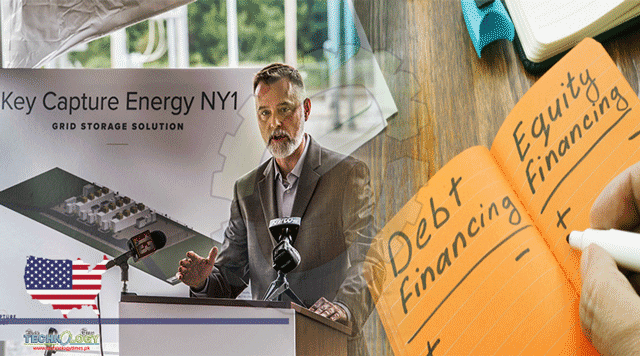US Battery Energy Storage Project Developer Key Capture Energy Has Secured US$93.3 Million Debt Financing For Portfolio Of Six Projects.

US Utility-Scale Battery Energy Storage Project Developer Key Capture Energy Has Secured US$93.3 Million Debt Financing For A Portfolio Of Six Projects In Texas. The deal covers three already-operational projects and three currently under development, adding up to 230MW of storage. The financing consists of a term loan for the period of construction plus five years as well as letters of credit and was arranged by CIT Group, Siemens Financial Services and Rabobank.
The company, which owns and operates battery projects in addition to developing them, said it will soon be issuing another project debt Request for Proposals (RfP) for 250MW of Texas projects, due to go online next year. Key Capture Energy claimed it already has “investment-grade offtakers” lined up for those. In an interview for our quarterly technical journal PV Tech Power a couple of months ago, Key Capture CEO Jeff Bishop said that the company had been a first-mover into the Texas market for battery storage systems, recognising potential when others had not.
“When we started developing in Texas, everyone told us it wasn’t a real market. Nobody would be building projects there,” Bishop said.
“Today, we’re the largest owner of storage – we’re currently building 200MW more in Texas, and everybody follows Texas right now.”
In a statement sent to press announcing the latest deal, Bishop said that Key Capture valued CIT, Rabobank and Siemens Financial Services’ “support and trust” as the company executed its growing pipeline of battery projects. “While this was a particularly complex financing with three projects under construction and three in operations, two different system integrators, and two unique battery types – all backed by three offtake counterparties – we are immensely proud of the innovation and creativity demonstrated by our lenders in the growing energy storage financing field,” Bishop said.
In August last year, Key Capture Energy (KCE) announced three large-scale Texas projects totalling 200MW (two of 50MW each and one of 100MW) with technology partners and system integrators Powin Energy and Mitsubishi Power (formerly and at that time known as Mitsubishi Hitachi Power Systems) using a bespoke lithium iron phosphate (LFP) battery system solution.
Mitsubishi Power is providing engineering, procurement and construction (EPC) services on those as well as servicing the systems’ DC equipment, power conversion systems (PCS) and high-voltage substations. Powin Energy, which itself just revealed that it had netted investment worth more than US$100 million — and gained new shareholders — is a system integrator for battery storage that Key Capture has worked with on previous projects.
Prior to embarking on those much larger projects, KCE deployed three projects of around 10MW each in Texas, which came online during 2020. In that PV Tech Power interview, CEO Jeff Bishop said the company typically goes into states and regions of the US where the company expects to see a booming market develop in the future. The company is targeting having 1GW online by the end of 2023 and so far has focused on Texas and in New York, where the company built one of the state’s first large-scale battery projects, the 20MW KCE1 facility in upstate New York.
“We start small, and do 10 or 20 megawatt projects initially to figure out all the known unknowns within a given market. And then once we get comfortable with the revenues, with the market structure, with the regulatory environment, commercial structures, then we expand and go bigger into the 50 to 200 megawatts-sized projects,” Bishop said.
‘Texas’ ERCOT is a fantastic market’
Texas’ market, particularly the 80%+ of the state covered by Electricity Reliability Council of Texas (ERCOT) jurisdiction, has been ripe for energy storage development, offering numerous energy and grid services opportunities that batteries can play into.
Other 100MW-sized projects are in development or construction in the region from developers Able Grid and Broad Reach Power, while French energy major Total just bought 600MW of under-development projects in the state along with a 2.2GW solar project pipeline. KCE’s Bishop claimed this week that his company was the first in Texas to build standalone battery storage projects “that were not just performing fast frequency response”.
Bishop told Energy-Storage.news a few months ago that KCE built up an in-house team of eight computer programmers to create market operations algorithms for the ERCOT market. He said that ERCOT has been on the forefront of correct market design in that its regulators define the attributes the grid needs “indiscriminately and then allows everybody to compete for them”.
“ERCOT is a fantastic market. Because they really don’t care what technology you are, whether you’re a diesel generator, whether you’re natural gas, whether you’re coal, whether you’re wind, whether you’re solar, whether you’re storage, they only care what value you provide to the grid, and they make sure that it’s priced correctly,” Bishop said.
“ERCOT has been on the forefront of that for a number of years, saying what the ERCOT grid actually will need, as far as reliability as far as resiliency, very clear price signals, and different parts of the state. And so all of those together allow for opportunities for energy storage.” The financing deal KCE struck was described as having an “innovative structure” by Rabobank managing director Claus Hertel. Legal advisers to the transaction were Norton Rose Fulbright and Clean Energy Counsel.
Also this week, AES Corporation subsidiary sPower announced the closing of a debt financing deal worth just over US$150 million for a 100MW / 400MWh standalone battery storage project in California. With that deal also described as “innovative” as well as being a “landmark deal”, the flow of significant project financing investment into energy storage may be just getting started.
This news was originally published at Energy Storage.